For safe fragrance oil concentrations, you'll want to follow these key ratios: facial products at 0.025-1%, body lotions at 0.25-2%, and perfumes at 10-25%. Start with lower percentages and adjust based on patch testing results. Use 1 ounce per pound (6.25%) as your standard starting point, and never exceed 5% for general topical applications. Sensitive areas like the face need extra caution – but there's much more to mastering these essential measurements.
Understanding Base Fragrance Percentages
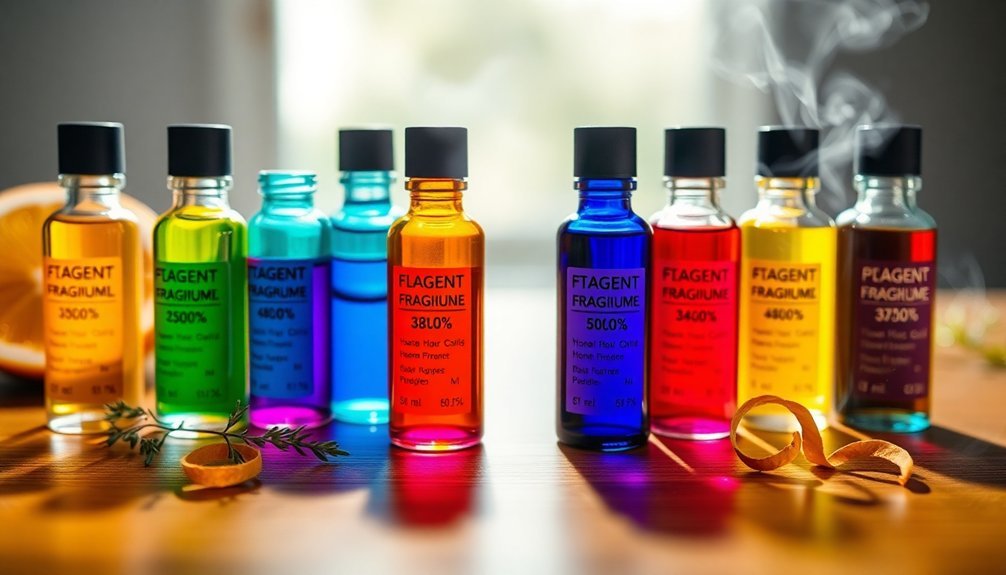
When formulating scented products, understanding the correct base fragrance percentages is essential for both safety and effectiveness.
You'll find that base fragrance concentrations typically range from 1% to 5% of your total product weight, depending on what you're making and how strong you want the scent to be.
Your essential oil dilution chart will vary by product type. For lotions and creams, you'll want to keep the amount of fragrance oil between 0.25% and 2%.
When formulating lotions and creams, keep fragrance oil concentrations between 0.25% and 2% for optimal safety and performance.
Scrubs and balms can handle slightly higher concentrations of 1% to 2%. If you're creating perfumes, you can use higher dilutions of 10% to 25%, with 15% being a reliable standard for daily wear.
Remember to start with lower percentages and adjust upward as needed to avoid skin irritation and maintain product stability.
Safe Dilution Ranges for Personal Care Products
You'll want to follow strict dilution guidelines when adding fragrances to personal care items, with face products requiring the lowest concentration at 0.025-1% and body products safely accommodating 0.25-2%.
For hair care items and body butters, you can incorporate fragrance oils at 1-2%, while essential oils should stay between 0.25-1% in scrubs and balms.
Before applying any fragranced product to your entire body, it's essential to perform a patch test on a small area of skin to check for potential reactions.
Facial Product Safety Limits
Ensuring the safe use of fragrance oils in facial products requires careful attention to dilution ratios.
When formulating facial lotions, you'll need to keep essential oils between 0.10% to 1% concentration, while fragrance oils shouldn't exceed 1% of your total formula.
You'll want to be extra cautious with facial applications since the skin on your face is more sensitive than other body areas.
Always perform a patch test before using any new product containing these oils.
Stay within the recommended usage rate of 0.025% to 1% for fragrance oils to prevent potential irritation.
If you're working with highly sensitizing oils, it's best to avoid them altogether in facial formulations.
Body Care Dilution Rates
Three key factors determine safe dilution rates for body care products: skin sensitivity, intended use, and oil type.
When creating body care products with essential oils, you'll need to follow specific concentration guidelines to guarantee safe application and avoid skin reactions.
For general body care products, maintain these dilution ratios:
- Regular body lotions and creams: 0.25% to 2% essential oil content
- Facial products: Keep concentration at 1% or lower
- Perfumes and fragrances: 10% to 25% dilution (use extra caution)
Always perform a patch test before applying any new product to your skin, and never use undiluted essential oils directly.
Remember that sensitive skin requires lower concentrations, while hardy skin types may tolerate higher dilution rates within the safe range.
Testing Before Full Application
Before applying any new fragrance-infused product to your entire body, performing a patch test is essential for preventing adverse skin reactions. You'll need to monitor the test area for 24-48 hours to verify your skin tolerates the fragrance concentration well.
| Product Type | Initial Testing Range | Maximum Safe Range |
|---|---|---|
| Face Lotions | 0.10% | 1.0% |
| Body Lotions | 0.25% | 1.0% |
| Body Creams | 0.25% | 1.0% |
| Body Oils | 0.25% | 1.0% |
| Bath Products | 0.25% | 1.0% |
Start with lower concentrations when testing new products to minimize potential irritation. If you're making your own formulations, begin at 0.25% for body products and 0.10% for facial applications. You can gradually increase the concentration if no sensitivity occurs, but never exceed the maximum recommended ranges for your safety.
Measuring and Calculating Oil Concentrations
Accurate measurement of fragrance oil concentrations plays an essential role in creating successful formulations. While the standard 1-ounce-per-pound ratio (6.25%) serves as a starting point, you'll want to take into account the total batch weight for consistent results.
Using a fragrance calculator helps you determine precise measurements and keeps you within safe usage limits.
To guarantee proper oil use in your formulations:
- Start with lower concentrations (3-4%) to test fragrance performance and prevent separation issues
- Calculate based on your total batch weight, including water, lye, and oils
- Always check IFRA guidelines for specific product category limitations
Carrier Oil Selection and Ratios
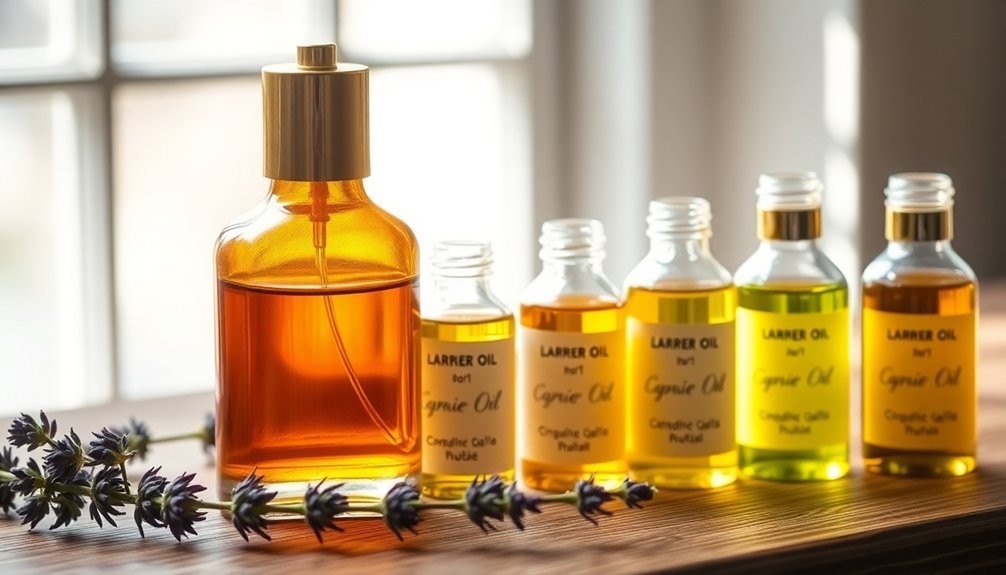
When selecting your carrier oils for fragrance blends, you'll find jojoba, sweet almond, and fractionated coconut oil are excellent choices due to their skin-friendly properties and ability to dilute effectively.
You can start with a 1:1 ratio of carrier oil to fragrance oil for general use, but increase to 2:1 for sensitive skin applications.
For different absorption rates, lighter oils like grapeseed will absorb quickly, while heavier options like avocado provide longer-lasting results.
Best Carrier Oil Options
Selecting the right carrier oil is essential for creating safe and effective fragrance blends. You'll want to choose a carrier oil that matches your skin type and complements your essential oils. Popular options like jojoba, sweet almond, and coconut oil each offer unique benefits for your skin while ensuring proper dilution of potent essential oils.
- Jojoba oil: Closely mimics your skin's natural oils, making it ideal for all skin types and excellent for facial applications.
- Sweet almond oil: Absorbs quickly and provides vitamin E, perfect for body massages and general moisturizing.
- Coconut oil: Offers antimicrobial properties and deep moisturization, though it may be too heavy for facial use.
Remember to perform a patch test before full application and maintain proper dilution ratios of 0.5% to 2%, using 1 ounce of carrier oil for every 3-12 drops of essential oil.
Blending Ratios by Usage
Mastering fragrance oil ratios is crucial for creating safe and effective aromatherapy products. When you're blending fragrance oil with carrier oils, you'll want to follow specific concentration guidelines based on your intended use.
For facial products, keep your fragrance oil use between 0.025% and 1% to protect sensitive skin.
Body lotions and creams can handle slightly higher concentrations, ranging from 0.25% to 2%.
If you're creating hair products, aim for 1% to 2% fragrance oil content.
For general aromatherapy blends, you can safely use 1% to 3% fragrance oil, depending on the oil's potency and your desired scent strength.
Always perform a patch test before applying any new blend, especially when using higher concentrations. This precaution helps prevent potential skin reactions and guarantees your product's safety.
Professional Perfumery Standards
Professional perfumery follows strict standards to assure both fragrance potency and user safety. When working with fragrance oil concentrations, you'll find that most professionals stick to a 15-25% range for premium perfumes. This level guarantees your scent makes an impact while remaining safe for skin contact.
For your guidance, here are the key concentration standards:
- 10% for everyday fragrances – perfect for regular wear
- 15-25% for professional perfumes – ideal for lasting impact
- Reduced percentages for citrus essential oils – especially in formulas exposed to sunlight
You'll need to pay special attention to IFRA guidelines when working with high sensitizing oils, as these can vary by application type.
Skin Safety Thresholds and Testing
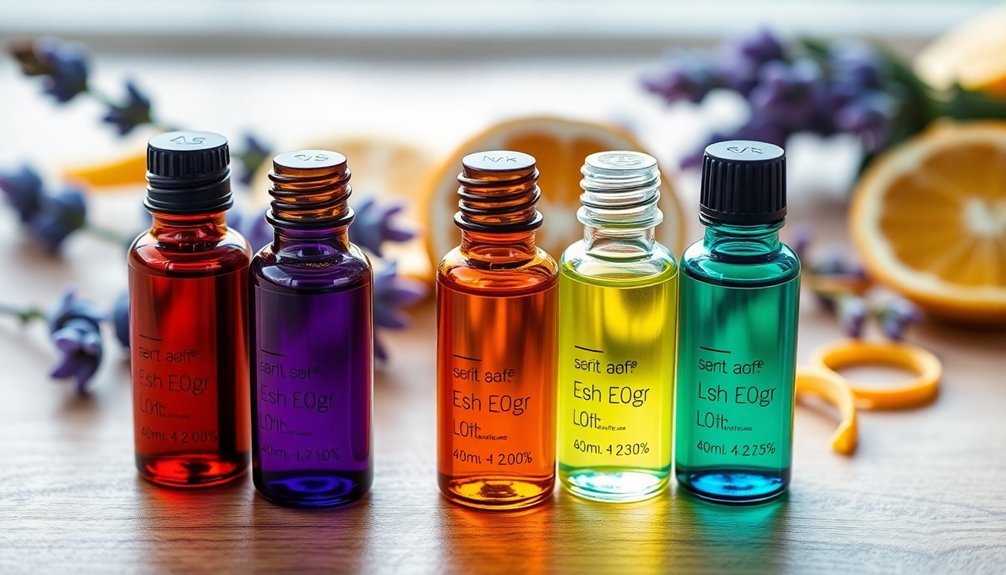
Before using any fragrance oil in your skincare formulations, you'll need to conduct a patch test on a small area to check for potential allergic reactions.
Your facial products should contain no more than 1% fragrance oil concentration, while body products can safely include up to 2% to prevent irritation.
Watch for warning signs like redness, itching, or burning during your patch test, as these indicate you should lower the concentration or avoid that particular fragrance oil.
Patch Testing Best Practices
To guarantee your safety when working with fragrance oils, proper patch testing is essential for identifying potential skin reactions or sensitivities.
Begin by applying a small amount of your fragrance oil product to your inner forearm, using a concentration that's on the lower end of recommended usage rates. Monitor the test area for 24-48 hours, watching closely for any signs of irritation.
- Apply a dime-sized amount of product to your inner forearm
- Record the exact concentration used and time of application
- Check the patch test area at regular intervals, noting any redness, itching, or swelling
If you have sensitive skin or known allergies, you'll want to be extra cautious with your patch test.
Keep detailed records of your results to help guide future formulations and avoid ingredients that don't agree with your skin.
Concentration Warning Signs
Careful attention to concentration warning signs helps prevent adverse skin reactions when working with fragrance oils.
When you're diluting essential oils, never exceed a 5% concentration for general topical use, and keep facial applications at 1% or less.
Watch for signs that your blend is too strong, including redness, itching, or burning during patch testing. You'll need to be especially cautious with highly sensitizing oils like cinnamon bark, which shouldn't exceed 0.07% concentration.
For citrus oils, be mindful of photosensitivity risks – reduce concentrations in products you'll use during daylight hours.
Always conduct a patch test before full application, even with properly diluted blends. If you experience any irritation during testing, immediately discontinue use and further dilute your mixture.
Essential Oil Blending Guidelines
When blending essential oils for topical use, you'll need to follow specific dilution guidelines to guarantee safety and effectiveness.
Never apply undiluted essential oils directly to your skin, as this can cause irritation or adverse reactions. For most applications, stick to a dilution rate between 0.5% and 2% of your total blend.
For safe oil use, follow these key guidelines:
- Use 3-12 drops of essential oil per ounce of finished product
- Limit facial applications to 1% dilution or less
- Consider each oil's individual properties and potency when calculating ratios
You'll find it helpful to use dilution calculators and charts to determine exact measurements for your formulations.
This assures you're creating safe, effective blends while maintaining proper concentration levels.
Storage and Stability Requirements
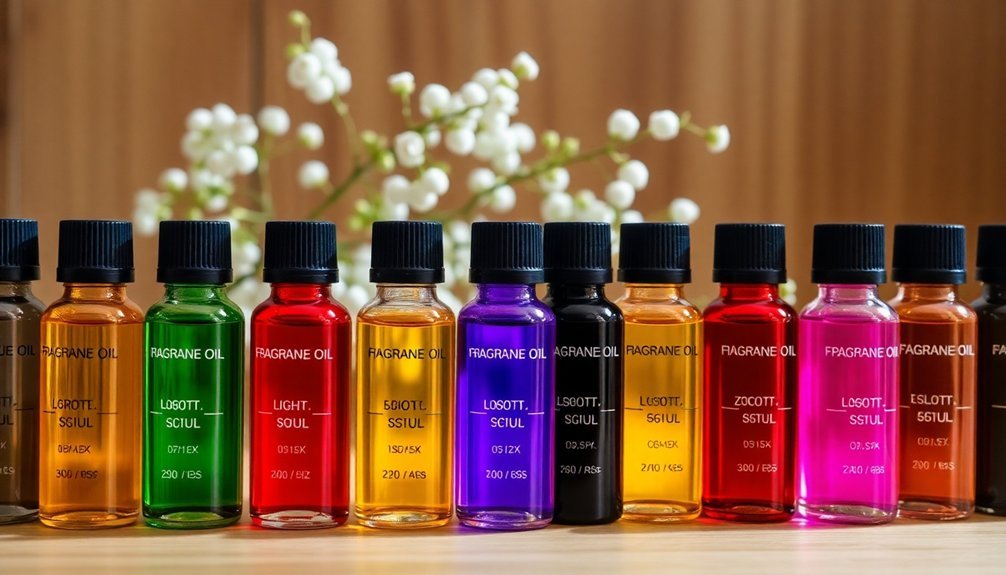
Proper storage of fragrance oils plays an essential role in maintaining their quality and extending their lifespan. You'll want to store your oils in either HDPE plastic or glass containers, as these materials prevent degradation and maintain stability.
Keep your fragrance oil collection in a cool, dark location, away from sunlight and heat sources to preserve potency and prevent oxidation.
You'll need to ascertain all containers have tight seals to minimize air exposure, which can lead to evaporation and weakened scents.
While most fragrance oils last 1-3 years when stored correctly, you should regularly inspect them for any changes in color, viscosity, or scent.
If you notice any of these changes, it's time to replace your oils, as they've likely degraded beyond their useful life.
Product-Specific Concentration Limits
Different skincare and personal care products require specific fragrance oil concentrations to maintain both safety and effectiveness.
When formulating your products, you'll need to follow careful guidelines to prevent skin irritation while guaranteeing proper scent strength.
For your reference, here are key concentration limits to follow:
- Face lotions need the lowest concentration at 0.025-1% fragrance oils to protect sensitive facial skin.
- Body lotions and creams can handle higher amounts between 0.25-2% for lasting fragrance.
- Scrubs, balms, and butter products work best with 1-2% fragrance oils for peak scent delivery.
Remember that shower products should stay within 0.25-1% concentration, while hair care items and beard balms can tolerate slightly higher levels at 1-2.5%.
These limits guarantee your products remain both safe and pleasantly scented.
Regulatory Compliance and Documentation
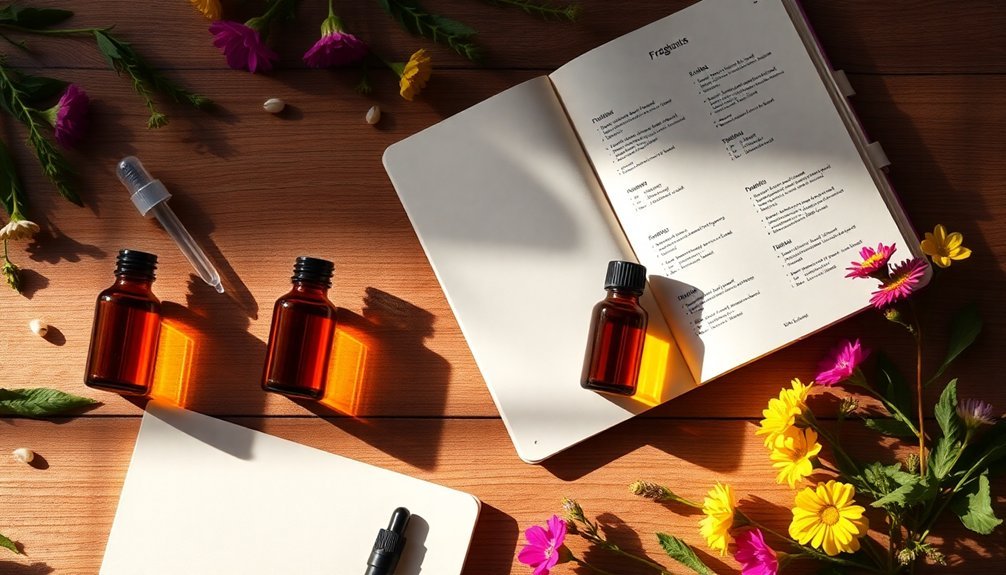
Beyond establishing the right fragrance concentrations, you'll need to maintain thorough regulatory compliance and documentation for your formulations. Keep track of every detail in your fragrance oil usage to meet IFRA guidelines and guarantee consumer safety.
| Documentation Type | Compliance Requirement |
|---|---|
| Safety Data Sheets | Review and store SDS for each fragrance oil |
| Batch Records | Document weights and percentages used |
| IFRA Guidelines | Track maximum usage rates by product type |
Maintain detailed records of your supplier communications, particularly when IFRA guidelines change. You'll want to document every measurement, formulation adjustment, and safety consideration in your process. This documentation isn't just about meeting regulations—it's essential for reproducing successful formulations and building consumer trust. Remember to regularly review your documentation system to guarantee it meets current regulatory standards.
Frequently Asked Questions
What Is the 30/50/20 Rule for Essential Oils?
You'll create balanced essential oil blends by using 30% top notes for initial impact, 50% middle notes for the main scent, and 20% base notes for lasting depth in your fragrance composition.
Is 10% Fragrance Oil Too Much?
Yes, 10% fragrance oil is generally too high for body products. You'll want to stick with 0.25-2% for safe skincare applications. If you're making perfume, you can go higher but always patch test first.
What Is the 30/50/20 Rule for Perfume?
You'll want to blend your perfume using 30% top notes for initial scent, 50% middle notes for the main character, and 20% base notes for lasting depth. This creates a balanced, long-lasting fragrance.
What Is the Dilution Guide for Essential Oils?
You'll want to dilute essential oils between 0.5% to 2% (3-12 drops per ounce). For facial use, keep it at 1% or less. Always mix with carrier oils to prevent skin irritation and sensitization.
In Summary
Working with fragrance oils requires careful attention to recommended ratios and safety guidelines. You'll need to stay within proper dilution ranges, select appropriate carrier oils, and follow product-specific concentration limits. Whether you're creating perfumes, lotions, or other scented items, maintain accurate measurements and documentation. Always check current regulations and safety standards before finalizing your formulations to guarantee compliant, stable, and safe products.
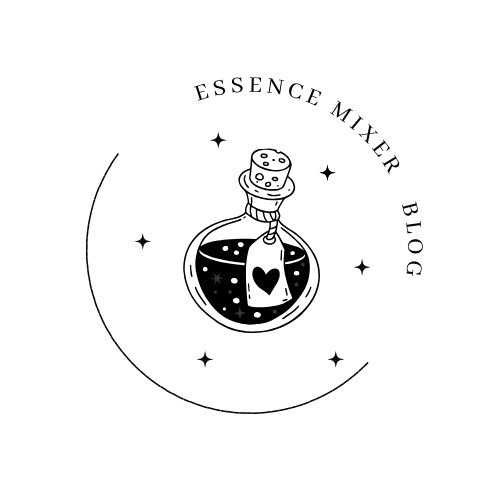
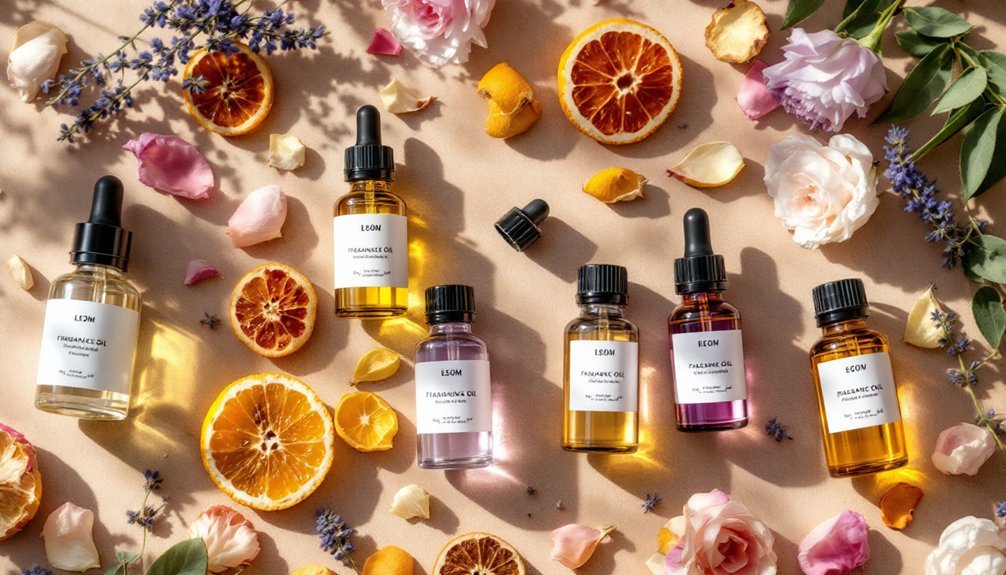



Leave a Reply